Need help?Contact us
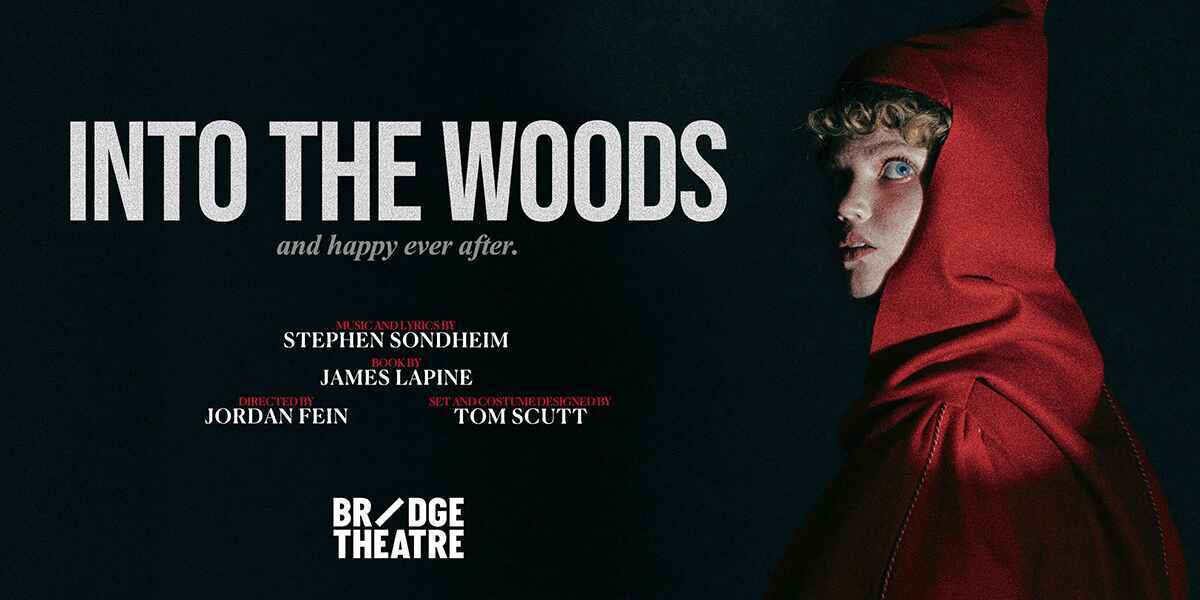
This production is recommended for ages 12+.
Performance dates
2 Dec 2025 – 30 May 2026
Run time: TBC
Includes interval
Why would you go into the woods?
To sell the cow To lift the spell To visit mother To see the king
Or maybe to find yourself?
In Stephen Sondheim and James Lapine’s dazzling musical, the Baker, the Baker’s Wife, the Witch, Jack, Little Red Riding Hood, Cinderella and Rapunzel take us beyond happy ever after to discover what really matters.
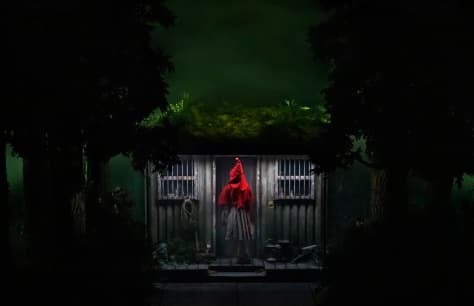
Stephen Sondheim and James Lapine’s multi award-winning musical weaves classic fairytales; Cinderella, Jack and the Beanstalk, Rapunzel, Little Red Riding Hood, into a single narrative about desire, consequence and community. The musical’s songs are clever, expressive and essential to the storytelling. Find out more about them below.
The first act of Into the Woods introduces us to the enchanted world where wishes drive every character’s journey.
This rousing opening number brings all our principal characters together, each with their deep wishes, from Cinderella’s longing to attend the king's festival to the Baker and his Wife’s hope for a child.
Cinderella reflects on her life and her mother’s words at her grave. We’re introduced to her wistful longing and quiet courage.
Little Red Riding Hood meets the Wolf (often portrayed by the same actor who plays Cinderella’s prince later in the show) an encounter that mixes innocence with danger, and a touch of desire. Sure, Little Red Riding Hood knows she shouldn’t follow this mysterious stranger into the woods, but she is visibly thrilled by spending time with this sly and seductive rogue.
Jack trades his cow Milky-White for “magic” beans and says farewell to his friend, while the Baker and his Wife weigh the risks and rewards of their quest.
After emerging from the Wolf's belly, covered in blood and determined to get a new cape out of her encounter, Little Red Riding Hood reflects on what she’s learned, namely “Scary is exciting / [but] Nice is different than good.” The song sees her lose her childish innocence, and part ways with her famous red cape.
Cinderella crashes into the Bakers Wife while running away from the king’s festival. The ball wasn’t what she expected, but “How do you know what you want till you get what you want and you see if you like it?” The Bakers Wife pounces for Cinderella’s golden slippers whilst the soon-to-be princess has her exponential crisis, but fails. In “First Midnight” characters reconnect after the ball, each wrestling with their day’s discoveries, aware of the passage of time and the shifting stakes.
Jack returns from the giant’s castle with tales of adventure, and an armfull of gold coins. It’s a showpiece for youthful bravado and recklessness, however we quickly realise that he’s still just a child when he cries and pleads with the Baker to give him his cow back. The Baker refuses and Jack climbs back up the stalk, determined to buy his friend back.
Cinderella’s Prince and Rapunzel’s Prince lament their loves in a comic duel of one-upmanship (or downmanship, as each swears he has it worse). It’s stupid and silly and so much fun.
The Baker and his Wife find strength in partnership as their quest continues, a heartfelt duet about teamwork and perseverance.
After finding out about her encounter with the Prince, the Witch warns her daughter, Rapunzel, about the “real-world” outside of her doorless tower. She begs her to “Stay a child while you can be a child”.
Cinderella wrestles with her decision to stay or run, in this tongue twister of a song she tells the Bakers Wife how she was stuck on the palace stairs after the prince covered it in pitch. She escaped the stairs with one shoe, which she gives to the Bakers Wife, before sprinting through the forest and back to her home.
Act 1 closes with the “good” characters enjoying their happy endings and the “bad” characters accepting their fate. The story looks like it's rounded off nicely, however, as a new beanstalk grows in the background, we know it’s not over yet - which is good, because we still have a whole act to go!
18 Dec, 2025 | By Sian McBride
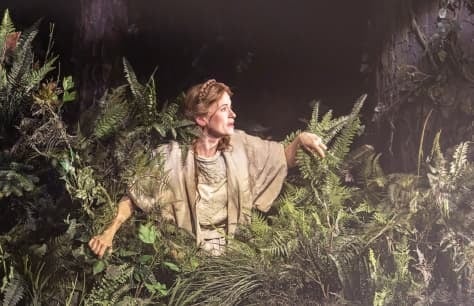
Go into The Bridge for a cow as white as milk, a cape as red as blood, hair as yellow as corn, and a show that’s pure as gold…
Stephen Sondheim’s tale of twisted fairy-tales bursts into life in Jordan Fein’s plump and lush revival. The first show at The Bridge to be staged end-on in over three years, the production completely immerses you in its rich and magical world as if you are standing next to Cinderella, brushing up against a fortune laying hen or swerving a Giants sandals.
Tom Scutt’s creative and intricate set pieces and costume designs transport you into the world fully. A special mention to Florinda (Gabrielle Lewis-Dodson), Lucinda (Hana Ichijo) and the Stepmother’s (Jennifer Hepburn) horse and carriage handbags, as well as Rapunszel's (Bella Brown) braided ladder hairpiece. These fun and quirky touches elevate the text's playfulness whilst also showcasing the musical’s central idea: nothing, and no one, is quite what they seem.
Gracie McGonigal’s Red Riding Hood is definite, obnoxious and sharply funny, a commanding performer who steals focus (and a loaf of bread, six buns and a few slices of cake) whenever she steps onto the stage. Yet beneath the bravado, McGonigal reveals real desire and vulnerability. It’s a turn with as many layers as one of The Baker’s (stolen) turnovers.
16 Dec, 2025 | By Sian McBride
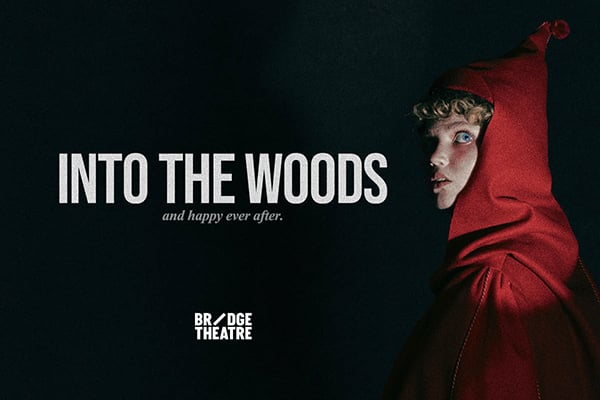
Theatre’s most twisted fairy tale has arrived at the Bridge Theatre. Into the Woods, Stephen Sondheim and James Lapine’s Tony Award-winning musical, returns in a bold new production that dives deep into a world where familiar stories blend, collide, and break apart. Playing for a strictly limited run, this reimagining promises an enchanting, unsettling, and richly theatrical journey…
This thrilling revival follows the Baker and his Wife, who set out on a perilous quest to break a wicked curse. Their search leads them into the heart of the woods, where they cross paths with Cinderella, Jack, Little Red Riding Hood, Rapunzel, and other beloved characters — each chasing a wish of their own.
But magic always comes at a cost. As dreams are granted and destinies shift, the characters are forced to confront loss, responsibility, and the uncomfortable truth that “happily ever after” isn’t always what it seems. With Sondheim’s iconic, intricately layered score, Into the Woods delivers a spellbinding blend of dark humour, emotional depth, and fairy-tale wonder.
12 Dec, 2025 | By Hay Brunsdon

Bella Brown has rapidly established herself as one of the most exciting rising talents in British musical theatre. Since graduating from ArtsEd in 2023, she has already built a portfolio many performers wait years to achieve - and she’s only just getting started.
3 Oct, 2025 | By Vivienne Shaw

We can finally see the woods from the trees (or the stars in the highly anticipated musical), as the cast has finally been confirmed for Into the Woods! Directed by Jordan Fein, Stephen Sondheim and James Lapine’s Tony Award-winning musical brings together characters from beloved fairy tales as they enter the forest to fulfil their quests; to sell the cow, to lift the spell, to visit mother, to see the king. But who will be venturing into the woodland this winter?
Katie Brayben leads the company as the Baker’s Wife, opposite Jamie Parker as the Baker. Brayben won an Olivier Award for Best Actress in a Musical for Beautiful: The Carole King Musical, and won in the same category eight years later for Tammy Faye. Parker is also an Olivier Award winner, taking home the statue for his performance in Harry Potter and the Cursed Child. He reprised the role on Broadway, where he received a Tony Award nomination.
Kate Fleetwood plays the Witch. She received Olivier and Tony Award nominations for Macbeth and has appeared in London Road, High Society, and most recently My Master Builder opposite Ewan McGregor.
Bella Brown plays Rapunzel. Brown is no stranger to standing on balconies, having recently played Alternative Evita in Jamie Lloyd’s summer blockbuster production of Evita! Fellow Evita cast member, and Olivier Award nominee, Chumisa Dornford-May takes on Cinderella, with Oliver Savile as Cinderella’s Prince and the Wolf. Savile’s West End appearances include Wicked, Les Misérables, and Phantom of the Opera. Rhys Whitfield, recently seen as Raoul in Phantom of the Opera, is Rapunzel’s Prince.
16 Sep, 2025 | By Sian McBride
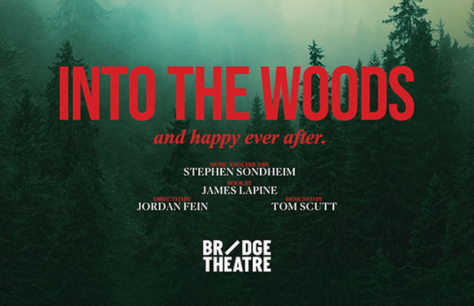
Into the Woods created by Stephen Sondheim (music & lyrics) and James Lapine (book), blends classic Brothers Grimm fairy‐tale characters; Cinderella, Jack (from Jack and the Beanstalk), Little Red Riding Hood, and Rapunzel, with an original story about a Baker and his Wife. Bound together by a Witch’s curse, these characters embark into the woods (can you see where the musicals came from?) to fulfill their wishes, only to discover that every wish carries unforeseen consequences.
The show first premiered at San Diego’s Old Globe Theatre in 1986 before transferring to Broadway in 1987. The macabre musical ran for 764 performances and was universally adored, winning Tony Awards for best score, best book, and best actress (Joanna Gleason as the Witch). The original cast album then went on to win the Grammy for best musical theater album. A fairytale moment for all involved.
But which classic characters made the leap from the storybook to the stage? Check out our guide to the Into The Woods characters below:
The Baker is a harried, insecure every‑man desperately trying to lift a curse that prevents him and his Wife from having a child. Reserved and protective, he grows into maturity through the trials of the woods, learning that life’s messy realities carry meaning alongside magic.
Pragmatic yet yearning, the Baker’s Wife seeks more than her simple life (and it is very restricted, her own ‘name’ doesn’t give her her own identity). At first she craves a child, and then she gets a taste of royalty. Smart and resolute, she becomes the emotional heart of Act II in songs like “Moments in the Woods,” where she wrestles with guilt, loss, and the complexity of choice.
A once-beautiful yet twisted mother and magical exile, the Witch curses the Baker’s family after her garden is stolen. She embarks on her own arc in search of love and control, ultimately realising that clinging to her stolen daughter won’t buy happiness. Her solos, including “Witch’s Lament” and “Last Midnight,” give one of the show’s most powerful emotional journeys.
Kind-hearted and enduring despite cruel treatment from her stepmother and stepsisters, Cinderella dreams of attending the king’s festival. When her wish comes true, she learns that the life she imagined doesn’t satisfy, and she must find her own balance between desire and fulfillment. She sings “On the Steps of the Palace” and joins ensemble pieces like “No One Is Alone.”
Charming, vain, and unreliable, the Prince pursues Cinderella passionately, but is all too ready to abandon her. In some productions, the roles of the Wolf and the Prince are doubled, emphasising his predatory desire. His number “A Very Nice Prince” (shared with Rapunzel’s Prince) skewers fairy‑tale romanticism.
A spirited, naïve girl who enters the woods to visit her grandmother, only to be seduced by the Wolf. Her journey teaches her the dangers of naiveté and entices her toward maturity. In Act II she delivers the stirring “I Know Things Now,” reflecting on knowledge gained and innocence lost.
A dream‑struck youth whose cow, Milky‑White, won’t give milk, Jack trades her for magic beans. Climbing the beanstalk, he encounters giants, wealth, and catastrophic consequences. Energetic and naïve, he ultimately learns responsibility through grief and regret. He sings “Giants in the Sky” in Act I and shares in the ensemble’s fights later.
31 Jul, 2025 | By Sian McBride

Opened in 2017, the Bridge Theatre is the first new theatre of its scale to be built in London’s commercial theatre sector in 80 years and has quickly established itself as one of London’s most exciting modern venues. Founded by Nicholas Hytner and Nick Starr (formerly of the National Theatre), the Bridge Theatre is located near Tower Bridge and boasts a flexible auditorium that allows for innovative staging configurations.
Since its opening, the Bridge Theatre has staged a host of notable productions and star-studded plays, including Julius Caesar’s groundbreaking promenade production starring Ben Whishaw and Richard II starring Jonathan Bailey. Its reputation for bold and inventive productions continues to draw major talent and enthusiastic audiences.
Situated in a vibrant cultural hub, The Bridge Theatre is a sought-after destination for those looking to experience a captivating London play. Whether you're intrigued by contemporary drama or timeless classics, the theatre offers some of the best views of the stage, perfect for taking in the best West End shows and immersing yourself in the magic of live performance.
Choosing the best seats at the Bridge Theatre really depends on the type of production and your personal preferences. The venue's innovative design means that every seat offers something special.
The stalls at the Bridge Theatre are flat-floor seating that offers a close-up, immersive view of the action — especially important in productions using the venue's signature thrust or in-the-round stage configurations. Seats in the central stalls (Rows C - J) offer a particularly great balance of proximity and full view.
Gallery 1 runs along the sides of the theatre and provides a more elevated view. These seats are perfect if you like a wider perspective of the staging and choreography, and they can be ideal for productions with complex sets or large ensemble casts.
Higher up and slightly more distant, Gallery 2 seats are typically more affordable. They still offer a good view, especially for productions that use a lot of overhead effects or aerial staging. If you’re looking for value without compromising too much on experience, Gallery 2 is a solid choice.
Different seating areas cater to different viewing preferences, and thanks to the thoughtful design, there’s really no “bad seat” at the Bridge Theatre!
28 Apr, 2025 | By Sian McBride

Standing ovations, critical acclaim, and a legacy that redefined Broadway and the West End – Stephen Sondheim’s musicals have it all. Known for his razor-sharp wit, emotional complexity, and masterful storytelling, Sondheim created characters that range from tragic antiheroes to whimsical dreamers. Each role is unforgettable, brought to life with lyrics and melodies that cut straight to the heart. And with Into the Woods returning to London at the Bridge Theatre from 2 December 2025, directed by Jordan Fein, there’s no better time to celebrate the best Stephen Sondheim characters of all time.
Dark, dangerous, and disturbingly sympathetic, Sweeney Todd remains one of Sondheim’s greatest creations. Wrongfully imprisoned for fifteen years, Todd returns to London hungry for vengeance. Armed with his razor, he unleashes terror on unsuspecting customers while partnering with Mrs. Lovett, the pie shop owner who finds a grisly way to make use of the bodies.
Todd is both victim and villain, a tragic antihero whose haunting baritone and tortured psyche make him endlessly fascinating. Through songs like “Epiphany” and “My Friends,” Sondheim plunges us into the depths of his madness, crafting one of musical theatre’s most chilling characters.
Smart, practical, and full of quiet determination, The Baker’s Wife is the beating heart of Into the Woods. She may run a small bakery, but her dreams are far bigger. Cursed with infertility by the Witch, she embarks on a fantastical quest to break the spell, tracking down a cow as white as milk, a cape as red as blood, hair as yellow as corn, and a slipper as pure as gold.
Unlike her husband, she’s resourceful and quick to act, often serving as the voice of reason. The Baker’s Wife represents desire, compromise, and the bittersweet reality that happy endings are rarely simple. Her character arc, especially in “Moments in the Woods,” captures the complexity of love, longing, and sacrifice in a way only Sondheim could write.
Bobby (or Bobbie, in the acclaimed gender-swapped revival) is one of musical theatre’s most complex protagonists. Turning 35, unmarried, and surrounded by married friends, Bobby is forced to reflect on his life, his choices, and his fear of intimacy. Through iconic numbers like “Being Alive” and “Someone Is Waiting”, Sondheim explores the messy, modern realities of love, loneliness, and commitment.
Far from a traditional romantic lead, Bobby is flawed, conflicted, and achingly human. It’s this honesty that makes him one of Sondheim’s most relatable characters - proof that sometimes the scariest journey isn’t into the woods, but into your own heart.
World-weary yet enchanting, Desiree Armfeldt is one of Sondheim’s most glamorous creations. A celebrated actress juggling lovers, regrets, and rekindled passion, Desiree embodies the sophisticated wit of A Little Night Music.
Her show-stopping ballad, “Send in the Clowns”, has become one of Sondheim’s most famous songs – a moment of vulnerability where Desiree’s mask slips to reveal heartbreak and longing. Complex, witty, and deeply human, she’s a reminder that love is rarely simple, but always worth pursuing.
Inspired by the real-life French painter, Sondheim’s Georges Seurat is an obsessive artist consumed by his vision. In Sunday in the Park with George, his dedication to craft pushes away the people he loves – especially Dot, his muse and mistress.
Through songs like “Finishing the Hat,” Sondheim gives voice to the tension between art and life, showing the sacrifices of genius and the loneliness of creation. Georges isn’t warm or charming, but he is endlessly compelling, a character who speaks to anyone who has struggled to balance passion with connection.
From the murderous wit of Sweeney Todd to the bittersweet dreams of The Baker’s Wife and the aching vulnerability of Bobby and Desiree, Stephen Sondheim’s characters are as iconic as the musicals themselves. They’re messy, layered, and deeply human – and that’s why we love them. As Into the Woods prepares to take over The Bridge Theatre in December 2025, it’s clear that Sondheim’s legacy will keep enchanting audiences for generations to come.
21 Sep, 2023 | By Kevin Thomas